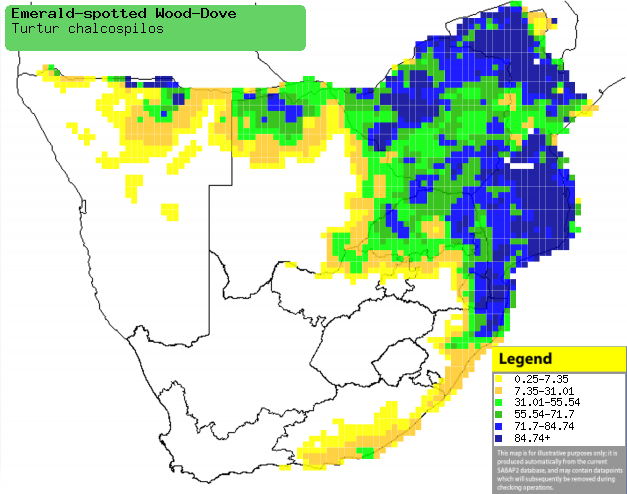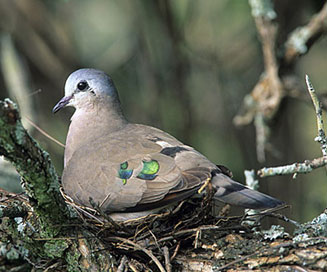|
Turtur chalcospilos
(Emerald-spotted wood-dove, Greenspotted dove)
Groenvlekduifie [Afrikaans]; Ivukazana [Xhosa];
isiKhombazane-sehlanze [Zulu]; Sitenderenkutji [Kwangali]; Mutondo, Njiva [Shona];
Sigulugwane [Swazi]; Xivhambalana (generic term for dove) [Tsonga];
Smaragdvlekduif [Dutch]; Tourtelette émeraudine [French]; Bronzeflecktaube
[German]; Rola-esmeraldina [Portuguese]
Life
> Eukaryotes >
Opisthokonta
> Metazoa (animals) >
Bilateria >
Deuterostomia > Chordata >
Craniata > Vertebrata (vertebrates) > Gnathostomata (jawed
vertebrates) > Teleostomi (teleost fish) > Osteichthyes (bony fish) > Class:
Sarcopterygii (lobe-finned
fish) > Stegocephalia (terrestrial
vertebrates) > Tetrapoda
(four-legged vertebrates) > Reptiliomorpha > Amniota >
Reptilia (reptiles) >
Romeriida > Diapsida > Archosauromorpha > Archosauria >
Dinosauria
(dinosaurs) > Saurischia > Theropoda (bipedal predatory dinosaurs) >
Coelurosauria > Maniraptora > Aves (birds) >
Order: Columbiformes > Family: Columbidae > Genus:
Turtur
The Emerald-spotted wood-dove is fairly common in many parts
of southern Africa, living in woodlands, savanna and valley bushveld. It forages
on sparsely vegetated ground, looking for fallen seeds and fruit, although
little more is known of its diet. It builds its own nest, which is a platform of
twigs, stems and roots, placed 0.5-6 metres above ground in a tree, bush or
Aloe. It lays 1-2 eggs, which are incubated mainly by the female, for 17 days.
The chicks stay in the nest for 15-17 days, before leaving.
Distribution and habitat
Occurs in sub-Saharan Africa, excluding arid areas. In
southern Africa it is is fairly common in northern Namibia, northern and
south-eastern Botswana, Zimbabwe, Mozambique, Swaziland and eastern and southern
South Africa. It generally prefers closed woodland, thicket in open
woodland, arid savanna, dry sand forest, valley bushveld, gardens and orchards.
|
 |
|
Distribution of Emerald-spotted wood-dove in southern Africa,
based on statistical smoothing of the records from first SA Bird Atlas
Project (©
Animal Demography unit, University of
Cape Town; smoothing by Birgit Erni and Francesca Little). Colours range
from dark blue (most common) through to yellow (least common).
See here for the latest distribution
from the SABAP2. |
Predators and parasites
Food
Forages on sparsely vegetated ground, probably feeding on invertebrates, fallen fruit and seeds, but
little is known about its diet. The following species have been recorded in its
diet:
- Plants
- seeds
- fallen fruit of Ficus bussei (Zambezi fig)
- Invertebrates
Breeding
- It builds its own nest (see image below), which is a platform of
twigs, stems and roots, placed 0.5-6.0 metres above ground in a tree, bush or
aloe.
 |
|
|
Emerald-spotted wood dove, Sericea farm,
South Africa. [photo Warwick Tarboton ©] |
|
- It lays 1-2 eggs, which are incubated mainly by the female for
approximately 17 days.
- The chicks stay in the nest for 15-17 days before leaving.
Threats
Not threatened.
References
-
Hockey PAR, Dean WRJ and Ryan PG 2005. Roberts
- Birds of southern Africa, VIIth ed. The Trustees of the John Voelcker
Bird Book Fund, Cape Town.
|
